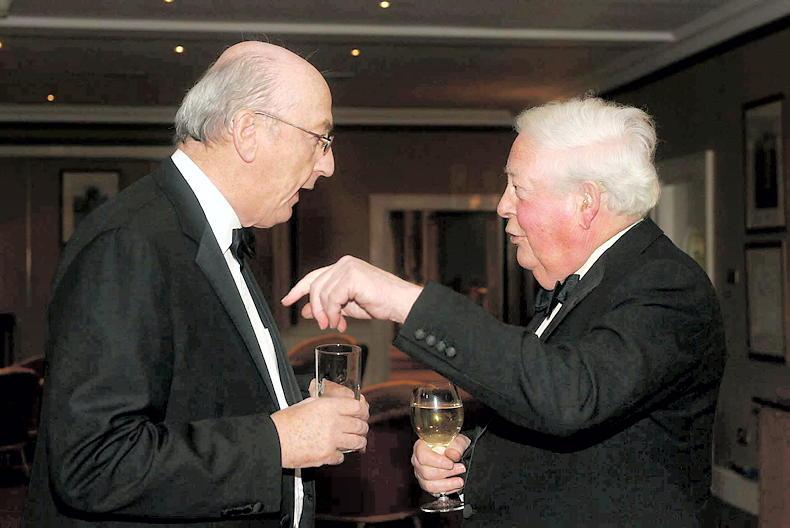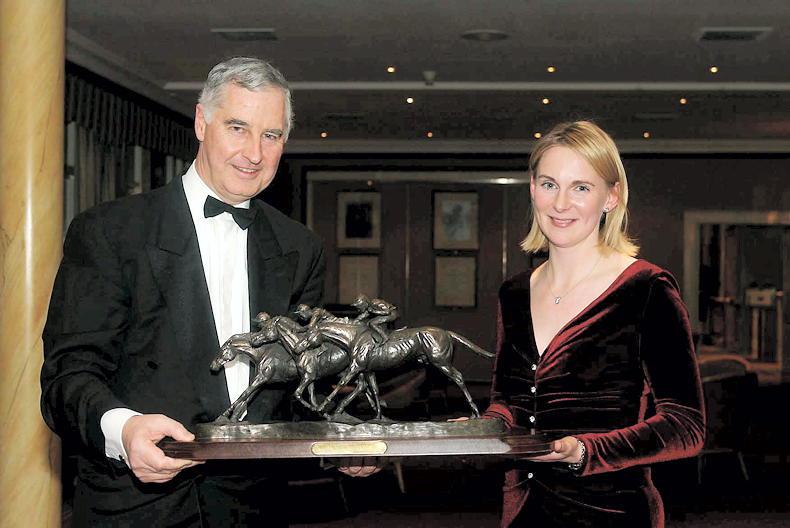2005
IT is, of course, a great pleasure and a great honour for me to be here this evening, especially in the sumptuous surrounding of the K Club.
Some of you might remember an advertising campaign by the Tate Gallery in London a few years ago which went something along the lines of ‘Ace café, with a good art gallery attached’. I feel that it would have been a better description of the K Club. I salute the farsightedness of Michael Smurfit in building such an extraordinary art collection, and adding the inspiration of the K Club to it.
I would also like to add my thanks to the Haefner family – good to see Martin and Martina with us tonight – and all at Moyglare Stud for making the great celebration possible. You are most generous and it is much appreciated.
I am well aware of the eminence of previous speakers, and I am particularly aware that when His Highness the Aga Khan spoke here four years ago he agreed that the Curragh track was one of the best in the world, but that the rest of the place needed modernising. Only a couple of years later he was asked by yourselves to buy the hotel at the back of the course, and give it to you so that you could do the work he had suggested.
I am therefore wary of making any suggestions concerning improvements to any part of Irish racing – for fear of the consequences – and indeed it would be impertinent for me to say anything critical in view of the wonderful hospitality that I have received, not only this evening but on many previous visits to race in this country.
The international racing world is a small one, and this has many advantages. We are aware of each other’s problems, though of course we always assume that our own problems are far greater than anybody else’s. Of course, the solution to other nations’ racing problems always seem remarkably straightforward, whereas our own issues are vastly complicated and awkward.
For instance, it would seem merely to need the stroke of a pen to ban medication in graded races in the United States, and thus make the Breeders’ Cup a completely fair world championship. Just spend five minutes with D.G. Van Clief and I think you will understand why, sadly, this is not as simple as it may seem.
Problems
Of course there are real problems everywhere, here as well as at home, and even in France – whatever Louis Romanet may let us believe – and for sure in Hong Kong and further east. Everybody in this room is well aware of them. It is so good to see the Government represented at this dinner, but no surprise considering where we are. But I don’t want to talk about these problems because you all know much more about them than I do, and you are in a position to do something about them which I am not. Sadly I have no easy solutions for you.
However, I did think that it might be a change to remind you of some of the good news stories that there are about racing, especially here in Ireland and in Britain.
Horse Racing Ireland was established in 2001. It is for you to tell me whether the following good news is thanks to the reorganisation and the partnership with the Turf Club, or good luck – or a combination of both. But certainly there is plenty of good news.
Since 2001 the number of fixtures has gone up by 13%; the number of races is up by 14%. Better still, the number of runners has increased by 16%. Racecourse attendance is up over 2%, Tote turnover on-course is up 34% and off-course betting is up a remarkable 92%. Which just goes to show the all-round strength of the Irish betting industry.
Good news
More good news. Horses in training are up by 26%, which creates problems of its own, but must be a whole lot better than being down by 26%! Sponsorship is up 10% and we all know how competitive that market place is. Finally, total prize money is up by a staggering 67%.
The close relationship between your Government and the racing industry is a wondrous thing. You are to be congratulated – albeit with a tinge of envy.
This country continues to supply brilliant jockeys to ride on the flat and over jumps. Our Cheltenham Festival goes from strength to strength and I know that Edward Gillespie gives a great deal of credit for that success to the enthusiastic support of racegoers from here. The fact that your trainers win a significant number of the races cannot do any harm either.
Royal Ascot will be back in Berkshire next year. A very, very tough assignment that is proving to be, but we will get there – just! Our renewal back home will be all the more exciting for the Aidan O’Brien battalions and he won’t be the only Irish trainer with high expectations.
Important race
Then there’s the Baileys Irish Champion Stakes. This has always been an important race but in the last few years, perhaps boosted by its inclusion in the World Racing Series and its vastly-increased prize money, it has become one of the three highest-rated races in Europe. Indeed, it is now in a positon to challenge both the King George at Ascot and the Arc in Paris to become the number one race in Europe before too long.
Competition such as this – which won’t be taken lying down of course, certainly by us at Ascot and I am equally confident by Louis Romanet at Longchamp – is good for the overall standard of Europe’s showpiece events.
The good news is not restricted to this country. The BHB was introduced in 1993, and again it is not for me to say that the good things that have happened to British racing are solely a consequence of this transfer of power, although of course I passionately believe that the BHB and its descendants are the right way for British racing to be managed.
At Ascot we are spending an awful lot of money - £200 million – building what amounts to a brand new racecourse with a significantly enhanced track, without any road crossings. As I said, it has been tough, but come and see us in June and make up your own minds.
The increasing horse population has demanded that the fixtures in Britain have increased significantly since 1995. Prize money has increased by 74%.
This has been really well-supported by sponsors’ contributions which have increased by the same percentage, from £10 million in 1995 to £18 million in 2004. The number of owners and horses in training are up.
Headline
There was a recent headline which really shocked a few people. It read ‘Racing cements position as UK’s second most popular sport’. The facts are that in 2004, after soccer, more people went racing than to any other sport. In fact, over six million people went racing, which was more than double the number who went to Britain’s third most popular sport, rugby union.
Of the top eight best-attended, one-off sporting events in 2005, four of them are race meetings; the Cheltenham Festival, Royal Ascot at York, the Grand National meeting and the Derby meeting. Number one was Wimbledon. So racing in England and Ireland has a great deal to be proud of.
I was delighted to hear the remarks earlier from your senior steward [Pierce Molony] concerning the increasing attention being paid to improving integrity. There is more money in racing here and in England than there has been for a long time, probably ever.
Balance
It is for you and your counterparts in England to strike a balance between the ever present, real and reasonable need to increase prize money and thus keep owners, trainers and jockeys happy, and to spend a reasonable percentage of the increasingly large pot to ensure that our sport is honest, the staff are fairly employed, and that the horses are well cared for.
As regards the welfare of horses, I believe that in the coming years much more attention will have to be paid to the quality, especially the evenness, of the going on turf tracks.
Ladies and gentlemen, in this country of the horse, I have no doubt that you are well aware of your responsibilities in these areas – integrity, staff welfare and equine wellbeing – and I have every confidence that racing in Ireland will continue to prosper and make for a cracking day out for participants and spectators alike, thus continuing to justify the enthusiastic support of your Government.


 This is a subscriber-only article
This is a subscriber-only article
 It looks like you're browsing in private mode
It looks like you're browsing in private mode






SHARING OPTIONS: